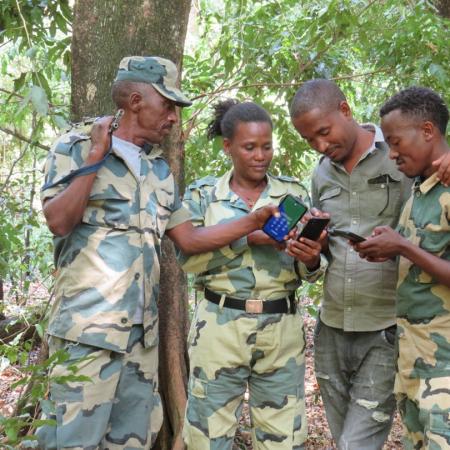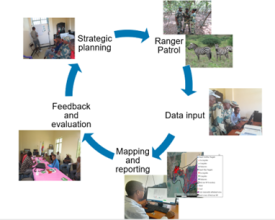
SMART: un sistema de vigilancia digital para la gestión eficaz de las áreas protegidas

El Parque Nacional de Nech Sar es una de las zonas protegidas más antiguas de Etiopía, conservada por su diversa flora, fauna y paisajes únicos. Sin embargo, el uso insostenible de los recursos supone una importante amenaza para el parque. La ausencia de protocolos y sistemas normalizados para registrar las actividades humanas ilegales y las amenazas obstaculiza el uso y la gestión eficaces del parque. La deficiente aplicación de los procesos de planificación, toma de decisiones y asignación de recursos agrava aún más el problema.
Para hacer frente a estos retos, el Programa de Biodiversidad y Silvicultura, financiado por el BMZ y ejecutado por la GIZ, introdujo la Herramienta de Seguimiento e Información Espacial (SMART). SMART es una herramienta que simplifica y mejora la recogida de datos, el análisis y la elaboración de informes en la gestión de áreas protegidas. Sirve de apoyo a diversas actividades de conservación, como la protección de la biodiversidad, la aplicación de la ley, la utilización de los recursos naturales y la gestión del turismo. Gracias a su facilidad de uso, SMART ofrece potentes opciones para una gestión y protección eficaces de los recursos naturales.
Contexto
Défis à relever
Retos medioambientales
El uso insostenible de los recursos es una de las amenazas que sufre el parque. El parque se ha utilizado durante mucho tiempo para la extracción de leña y carbón vegetal como medio de subsistencia. Esto ha provocado la destrucción de ecosistemas y la pérdida de biodiversidad.
Desafíos sociales
El sistema tradicional de vigilancia y registro de datos de las fuerzas del orden se basaba en el papel, lo que hacía que la recopilación y el análisis de datos fueran costosos y lentos, y contuvieran muchos errores e incoherencias. Además, las comunidades locales sufrieron trastornos en sus medios de subsistencia, implicaciones sanitarias e inestabilidad comunitaria debido a la gestión insostenible e ineficaz de las áreas protegidas.
Retos económicos
Con el creciente número de desempleados en los alrededores del parque nacional, la dependencia de los recursos del parque era motivo de gran preocupación. Cientos de fardos de leña se extraían diariamente del bosque, la producción de carbón vegetal y la pesca insostenible se llevaban a cabo de forma generalizada con fines comerciales.
Ubicación
Procesar
Resumen del proceso
La planificación estratégica basada en SMART sienta las bases de un funcionamiento eficaz mediante el establecimiento de metas, objetivos y planes procesables. Define la dirección y las metas que deben alcanzarse.
El patrullaje basado en SMART y la recopilación de datos sobre el terreno se aplican a continuación como parte del plan estratégico. Las actividades de patrulla se llevan a cabo centrándose en áreas específicas identificadas mediante la planificación estratégica. Durante las patrullas, se recopilan datos sobre el terreno, que incluyen observaciones, incidentes y otra información pertinente.
El seguimiento y la elaboración de informes SMART utilizan los datos recogidos sobre el terreno para supervisar los avances, medir el impacto de las medidas aplicadas y evaluar la eficacia del plan estratégico. Esta información se comunica y analiza para tomar las medidas adecuadas, identificar áreas de mejora y tomar decisiones informadas para la adaptación continua de los planes.
En resumen, la planificación estratégica basada en SMART sirve de marco orientador, mientras que el patrullaje y la recopilación de datos sobre el terreno basados en SMART proporcionan la información necesaria para el seguimiento y la elaboración de informes, que a su vez sirven de base para futuras iteraciones de la planificación estratégica. Los tres componentes trabajan juntos en un proceso cíclico, garantizando la gestión adaptativa y la mejora continua.
Bloques de construcción
Planificación estratégica basada en SMART
La planificación estratégica basada en SMART es un enfoque que consiste en establecer objetivos específicos, mensurables, alcanzables, pertinentes y sujetos a plazos para orientar el desarrollo y la aplicación de estrategias. La plataforma SMART permite a la administración del parque mejorar la eficacia de la gestión en términos de reducción de las actividades ilegales y mejora de los esfuerzos de los equipos de patrulla y de la eficacia de la asignación de recursos.
La planificación estratégica basada en SMART se utiliza para
- Establecer objetivos numéricos y espaciales - Los coordinadores de SMART en el parque, en colaboración con la administración del parque, establecen objetivos numéricos y espaciales para todos los equipos de patrulla y preparan planes mensuales de despliegue para las partes terrestre y acuática del parque. Los objetivos ayudan a establecer puntos de referencia claros y mensurables para las metas y objetivos de los equipos de patrulla en las zonas protegidas. Esto facilita el seguimiento de los progresos y la medición del impacto de la planificación estratégica y de los esfuerzos de aplicación de la ley.
- Crear mecanismos de gestión adaptativa - Los mecanismos de gestión adaptativa son útiles para crear continuamente un plan de aplicación de la ley, actuar sobre el plan, medir el impacto del plan y crear un nuevo plan mejorado basado en esa información. Al aprender de los resultados y revisarlos, los mecanismos adaptativos ayudan a hacer frente a las incertidumbres y promueven estrategias de gestión eficaces en sistemas dinámicos.
Factores facilitadores
Se creó un comité de operaciones SMART para aplicar mecanismos eficaces de gestión adaptativa que permitan la creación, ejecución, medición y mejora continuas de los planes. El comité hizo posible la planificación estratégica orientando el funcionamiento, la elaboración de informes, la presupuestación y la planificación de las patrullas SMART, garantizando su sostenibilidad logística y financiera, gestionando la coordinación interna del departamento y coordinándose con otros organismos encargados de hacer cumplir la ley.
Lección aprendida
La principal lección aprendida es que el éxito de la implantación y puesta en marcha de SMART depende en gran medida del compromiso y la voluntad de los gestores de los parques nacionales de cambiar los sistemas y prácticas de gestión. La introducción de nuevos sistemas como SMART debe hacerse de forma gradual, para dar tiempo suficiente a su adopción por parte de los usuarios y garantizar que los datos recopilados sean precisos y coherentes. Se requiere una planificación y formación adecuadas para que la implantación y el uso de la plataforma sean lo más fluidos y sencillos posible.
Patrullaje basado en SMART y recogida de datos sobre el terreno
El patrullaje y la recogida de datos sobre el terreno basados en SMART es una metodología que utiliza el marco SMART para orientar y optimizar eficazmente las actividades de patrullaje y los procesos de recogida de datos sobre el terreno. La recopilación de datos SMART está automatizada por CyberTracker, una aplicación que captura datos y proporciona capacidades de visualización. En la base de datos SMART se implementó un plug-in CyberTracker configurable por las patrullas para documentar las actividades ilegales en los parques nacionales. Está específicamente diseñado para su uso en el Parque Nacional de Nech Sar, con formatos de recopilación de datos estructurados en torno a las amenazas, la fauna y los hábitats. El modelo de datos y los protocolos de recogida se centran en recopilar únicamente los datos necesarios para una gestión eficaz de las patrullas y los indicadores de gestión.
El patrullaje y la recopilación de datos sobre el terreno basados en SMART han simplificado y agilizado los flujos de trabajo y han aumentado la precisión y coherencia de los datos. La plataforma también ha facilitado a la dirección el registro de sus actividades diarias y ha contribuido a reducir la carga de trabajo de los equipos de patrulla al disminuir en un 50% el tiempo dedicado a archivar los datos recopilados. Los protocolos detallados y normalizados de recogida, almacenamiento, gestión y procesamiento de datos en SMART apoyan el cumplimiento de la ley y la gestión adecuada del parque nacional y sus recursos.
Factores facilitadores
Los 54 guardabosques de primera línea recibieron formación sobre el patrullaje basado en SMART, los protocolos de recopilación de datos y la recopilación de datos sobre el terreno utilizando la aplicación móvil SMART. Los protocolos de recogida de datos SMART de los guardabosques y los cuadernillos de bolsillo con procedimientos paso a paso (plastificados con materiales impermeables) fueron elaborados y utilizados por el personal de gestión (guardabosques) durante la recogida de datos sobre el terreno.
Además, para colmar las lagunas en el registro de datos de campo durante la misión de patrulla, se proporcionó orientación continua a los jefes de los rangers de patrulla, a los jefes de despliegue de la misión de patrulla y a los rangers seleccionados.
Lección aprendida
La lección aprendida de la aplicación del patrullaje basado en SMART y la recogida de datos sobre el terreno es que es necesario simplificar el lenguaje utilizado en los modelos de datos de la plataforma para mejorar la precisión de la recogida de datos. No todos los guardabosques están familiarizados con los nombres científicos y la terminología de la ecología. Por este motivo, el anterior modelo de datos SMART, que contenía nombres científicos de las especies, dificultaba su identificación por parte de los guardabosques. Sin embargo, al simplificar a nombres comunes, se observó una mejora en la recogida de datos.
Seguimiento e informes SMART
SMART se utiliza como base de datos de seguimiento para el archivo sistemático de datos, documentación, análisis y procesamiento de datos. También se utiliza para preparar y evaluar los informes de las patrullas y las sesiones de información con los guardabosques. En el parque se creó una sala de operaciones SMART que se utiliza para interpretar los informes mensuales de las patrullas, preparar los comentarios de los equipos de patrulla, desarrollar estrategias de patrulla adaptables y planificar el despliegue de los equipos de patrulla por parte del comité SMART.
SMART proporciona una plataforma automatizada para facilitar la introducción de datos, el análisis y la generación de informes. Reduce el tiempo de análisis y elaboración de informes de más de 12 días a 2-3 horas utilizando el gestor de bases de datos SMART. También permite elaborar informes de todo el espectro de trabajo que realiza la dirección del parque. SMART genera una gran variedad de informes y gráficos personalizables, pero estandarizados, por ejemplo de indicadores de amenazas, estadísticas de esfuerzo de las patrullas y resúmenes del rendimiento individual de los guardabosques.
Factores facilitadores
Con el fin de mejorar los conocimientos y la capacidad de los expertos del parque para analizar, generar informes e interpretar los datos de las patrullas y el seguimiento, ocho expertos siguieron cursos de capacitación.
Además, el comité operativo de SMART desempeña diversas funciones, entre ellas dirigir las operaciones, supervisar la elaboración de informes, presupuestos y planificación de las patrullas SMART. También garantizan la sostenibilidad logística y financiera de estas patrullas, gestionan la coordinación interna del departamento y facilitan la coordinación con otros organismos encargados de hacer cumplir la ley.
Lección aprendida
La principal conclusión es que la formación eficaz en materia de gestión adaptativa de patrullas, seguimiento, mecanismos de despliegue y sistemas basados en SMART es esencial tanto para los responsables de la gestión como para los miembros del equipo operativo de SMART. Además, la realización de sesiones informativas y el suministro de información coherente a los equipos de patrulla son componentes esenciales para la planificación estratégica, el despliegue y la elaboración de informes de las patrullas.
Impactos
Impacto medioambiental
La recopilación y el análisis de datos SMART han permitido a los gestores del parque nacional rastrear y evaluar las actividades ilegales en el parque y desarrollar estrategias para combatirlas. La destrucción de los recursos naturales y las actividades ilegales como la producción de carbón vegetal, la tala de madera, la pesca y la caza han disminuido con el tiempo.
Impactos sociales
La preservación de la identidad cultural entre las comunidades locales y el sentido de pertenencia y conexión que los individuos tienen con su patrimonio se ven reforzados gracias a la protección del parque. Además, la conservación del parque garantiza el bienestar general de las comunidades locales.
Impacto económico
El despliegue de SMART ha supuesto un aumento significativo de la eficiencia en la recogida de datos, ya que ha reducido el tiempo de recogida de datos en un 50%. La planificación del despliegue de patrullas basada en datos y la asignación de recursos han permitido reducir las patrullas regulares en un 35%, aumentando al mismo tiempo las misiones de patrullaje estratégico y conjunto. Este enfoque racionalizado ha permitido asignar el tiempo y el dinero de forma más eficaz y ha aumentado la precisión de los datos.
Las comunidades locales que viven cerca de las zonas protegidas y los bosques obtienen beneficios económicos de la mejora de la gestión y la conservación. Las zonas bien gestionadas atraen a visitantes que realizan actividades de ecoturismo, lo que a su vez beneficia a las comunidades circundantes.
Beneficiarios
Dirección y personal del parque nacional,
Comité de operaciones SMART,
Guardas departamentales,
Equipos de patrulla,
Instituciones educativas (Wondo Genet College),
Autoridades locales (responsables de la toma de decisiones) y
comunidades locales.
Objetivos de Desarrollo Sostenible
Historia

Bayush Terefe, guardabosques de 36 años del Parque Nacional de Nech Sar, ha sido responsable de dirigir un equipo de 5 a 7 guardabosques que patrullan a diario para vigilar las actividades ilegales, rastrear e interceptar a los furtivos y abordar los conflictos entre humanos y fauna salvaje. Sin embargo, la eficacia del equipo de patrulla era escasa debido a la irregularidad y desorganización de los sistemas de patrulla, sin mecanismos de rendición de cuentas ni sistemas de evaluación del rendimiento.
En respuesta, Bayush y sus colegas recibieron formación sobre patrullaje avanzado, aplicación de la ley y protocolos de patrullaje y recopilación de datos basados en SMART. A pesar de la resistencia inicial a la plataforma, Bayush y su equipo pronto se dieron cuenta de las ventajas del patrullaje y la supervisión basados en SMART, lo que se tradujo en un aumento de la motivación y el rendimiento. Con el nuevo sistema, solo se tarda un minuto en registrar varias observaciones simultáneamente, lo que aumenta la eficacia de las patrullas diarias.
Bayush comparó la situación antes y después de la introducción del patrullaje basado en SMART. "El sistema de patrulla y vigilancia basado en SMART tiene múltiples ventajas. Por ejemplo, antes del sistema de patrulla basado en SMART, mis colegas y yo dedicábamos mucho tiempo y esfuerzo a registrar en papel las actividades ilegales y los indicadores ecológicos encontrados, pero ahora sólo se tarda un minuto en registrar varias observaciones simultáneamente y podemos realizar diversas tareas durante la patrulla y la vigilancia".
Además, la implantación de un sistema de evaluación de guardabosques basado en SMART ha permitido evaluar con precisión los esfuerzos del equipo de patrulla y de cada uno de los guardabosques. La evaluación anual del rendimiento, los premios y el sistema de ascensos de los guardabosques pasó del tradicional juicio subjetivo a una métrica basada en el rendimiento que se verifica a través de SMART.
Bayush explicó además cómo el sistema de evaluación de guardabosques basado en SMART ha aumentado la motivación y el rendimiento de los guardabosques. Mencionó que recibir el reconocimiento adecuado por lo que han logrado y los esfuerzos que han realizado durante sus misiones de patrulla ha sido una de las principales motivaciones para que todos los guardabosques sigan desempeñando sus funciones lo mejor posible.
La introducción de SMART ha mejorado enormemente la eficacia de Bayush y su equipo al reducir el tiempo y el esfuerzo necesarios para registrar las observaciones. Además, les mantiene motivados al medir con precisión el esfuerzo continuo y los resultados de los equipos de patrulla en la gestión del parque.




